Recent Storm Damage Posts
Consider Calling a Professional for Sewer Backup Cleanup
7/20/2022 (Permalink)
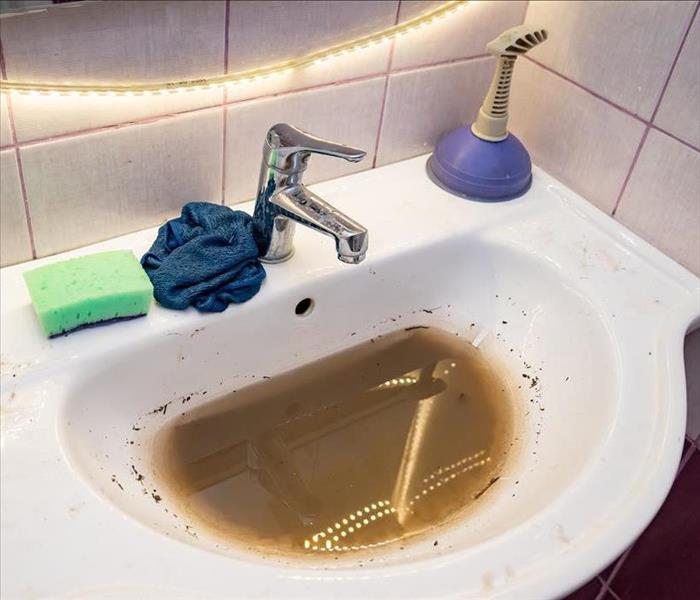 Sewer backup
Sewer backup
From hearing gurgling sounds while flushing to noticing a bathtub backup or noticeable odors when running water in a sink, there are many indications that your Clearfield, UT, home has a sewer backup. After the mess happens, it is important to consider the cause and take the proper steps for safe cleanup.
Common Backup Causes
While some sewer issues may be out of your control, there are common culprits that may be preventable. Key causes include:
Clogs: Like your drains, sewer lines also get clogged. The easiest way to avoid both types is to ensure everyone in the home only flushes what is meant to be flushed down the drains or toilet.
Tree Roots: Depending on the type of material your plumbing is made out of, they may be prone to damage by tree roots. Roots may easily find a way in and create cracks that may lead to a line collapse. Although difficult to prevent, switching to plastic pipes or having a plumber regularly clean the main line can stop a bigger issue.
Sewer Main Issues: Unless your home has its own septic system, the plumbing in it all leads to the same main city sewer. If that main has an issue, it may affect an entire neighborhood. Heavy rainfall is often the cause of this type of sewer issue.
Steps for Sewer Backup Cleanup
Anytime there is a water issue associated with the sewer, it should be approached as if it was caused by natural flooding. That means considering it contaminated water that needs to be properly taken care of. If dealing with a small amount of water, it may be a relatively easy cleanup. If the mess is large, it’s recommended to contact a water damage cleanup and restoration company to ensure your home is returned to a safe environment.
Regardless of the situation you find yourself in, here are key steps when dealing with sewer water:
- Prior to cleanup, ensure that the water hasn’t risen high enough to reach any electrical outlets. If it has, turn off the power and contact an electrician to ensure it is safe to enter the area.
- Wearing protective gear is a must. This should include eye protection, a face mask, rubber boots and disposable clothing.
- During cleanup, ensure the main water line valve is shut off. Even if another area of the home isn’t affected, using a sink or toilet may cause an additional backup.
- If possible, open any windows in the affected area to get proper ventilation.
- The most important part of the cleanup process is removing the water. A wet/dry vacuum may quicken this process.
- Determine which belongings may or may not be salvageable. Items that are made out of a porous material may need to be properly disposed of.
- The final steps require cleaning and sanitizing every part of the affected area.
Dealing with a sewer backup isn't as simple as mopping up. Prior to dealing with the mess, it is important to determine the cause of the problem and follow safety guidelines when handling the contaminated water.
Tips for Repairing Your Roof After a Storm
7/12/2022 (Permalink)
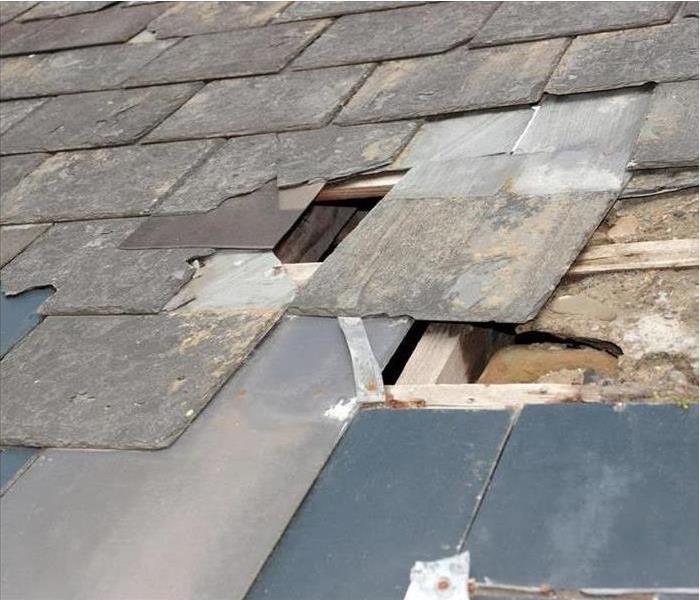 A storm may leave severe roof damage.
A storm may leave severe roof damage.
A dangerous storm in Clearfield, UT, can cause more than just flooded streets. It may also wreak havoc on your home. Hail and debris caught in wind currents can leave you in need of some serious roof repair. Knowing the right steps to take can help you minimize overall damage and protect your home.
3 Tips to Minimize Damage After a Storm
1. Contact Repair Professionals
Before you can fix the problem, you need to know how much roof damage you have. Roofing professionals are trained to spot problem areas:
- Broken or missing shingles
- Damaged flashing
- Dented gutters and spouts
As soon as they know what they need to fix, they can start the repair process. They replace broken materials and get your roof back to normal.
2. Board Up Vulnerable Spots
An important part of the roof repair process is protecting the vulnerable spots that the storm left behind. If your roof has a lot of damage, the technicians may not be able to fully restore it in one visit. In the meantime, you will need board-up services to keep additional precipitation, dirt and pests from getting into your home through the open spaces.
3. Inspect Interiors
Exterior hail and wind damage are not the only issues you need to address. If the protection your roof offers is compromised, you may also have some water damage inside your attic. Storm damage mitigation experts can find the problem and remedy any issues that roof leaks have caused. The faster they are able to tackle the problem, the less secondary damage you'll have to worry about.
There are multiple factors that could cause serious damage to your home during a storm. Hail, high winds and heavy rain can lead to costly roof repair. It is important to call for a professional inspection right after the storm passes so that any necessary repairs and mitigation can start as soon as possible. Protect your home from further damage by acting quickly.
Preparation Tips for Winter Storm Season
5/24/2022 (Permalink)
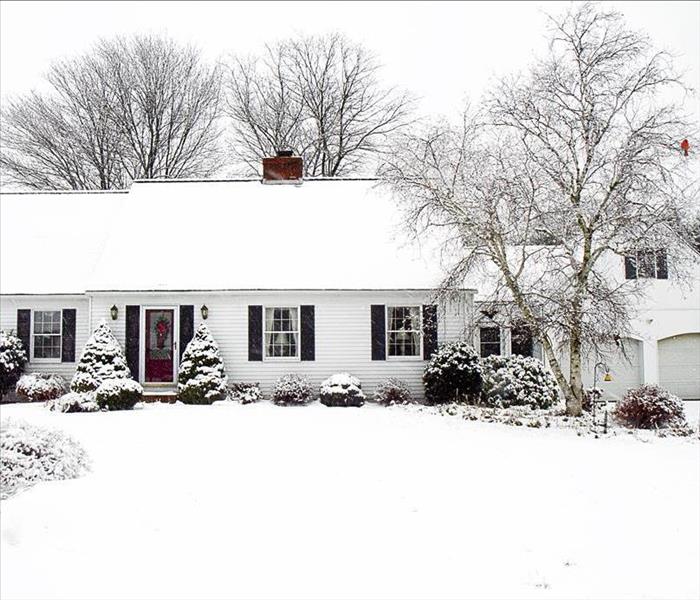 Be ready for Winter Storms by Following our Tips.
Be ready for Winter Storms by Following our Tips.
Caring for your home in Clearfield, UT, is a year-round job. You probably have an ongoing list of tasks to keep up with regular maintenance as well as specific projects and upgrades you want to make. As winter storm season approaches, there are a few things you need to add to your checklist to make sure your house is ready to brace itself against the changes in the weather.
Be ready for Winter Storms
Roof Damage Prevention
Your roof is one of the main protections your home has against the elements. It is a fundamental part of the building envelope that keeps your interiors dry. While it's important to keep the roof in good shape throughout the year, it's especially vital to ensure there are no weak spots or unnecessary pressure on it during the winter.
There are several ways to prevent roof damage during the winter:
- Clean debris out of gutters and downspouts
- Have the roof inspected for loose shingles or joints
- Test for air leaks that can lead to ice buildup
- Keep trees and shrubs trimmed to minimize the threat of damage during a storm
Pipe Protection
One of the most common causes of water loss in residential properties, particularly during a winter storm, is a pipe break. If your plumbing isn't properly insulated, the pipes can freeze and burst. Any water that is in them then gushes into the surrounding space.
To prevent this from happening, water damage mitigation experts recommend that you insulate your pipes and maintain a constant warm temperature in your home. It's also a good idea to keep cabinets open during a hard freeze so that warm air can flow more freely to the pipes inside them.
Energy Conservation
Higher utility costs are often a challenge for homeowners during colder months. At first glance, the spike may seem normal, as the heating system must work harder to combat the freezing temperatures of the latest blizzard and keep your home's interior warm. The change in weather may not be the only thing driving up the electric and gas bills, though.
Warm air escapes to the outside by any means necessary. Check the seals around your windows and doors to ensure that there are no leaks. The more you can keep the warmer air inside where it belongs, the lower your utility costs are likely to be.
Emergency Preparation
Finally, you need to plan for dire emergencies. No matter how well you maintain your home, a blackout may occur at some point during the winter. A backup generator can keep your lights on and the heater running, and a sump pump in the basement can get rid of standing water if a pipe break or groundwater incident occurs. Always keep shelf-stable food, first aid kits, batteries, flashlights, bottled water and sanitation supplies stocked and easy to access.
Your home maintenance checklist is something you need to pay attention to all year. If a winter storm is on its way, though, there are a few extra tasks you may need to add to it. Staying weather aware and prepared protects your home and everyone in it.
Common Causes of Basement Floods
2/23/2022 (Permalink)
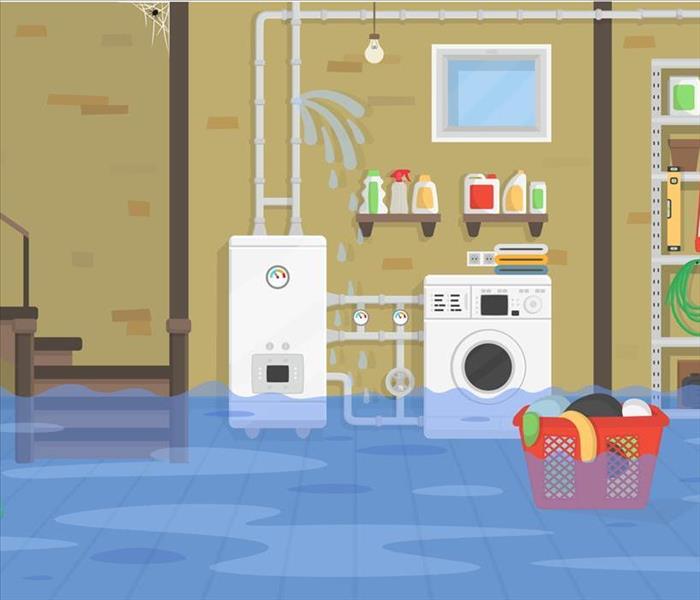 Follow these Tips to learn about Basement Floods and avoid Storm Damage in your Clearfield, UT property.
Follow these Tips to learn about Basement Floods and avoid Storm Damage in your Clearfield, UT property.
A storm in Clearfield, UT, can cause a lot of damage to your roof and other parts of your home. It may lead to a flooded basement, especially if there is a lot of precipitation involved. There are many ways floodwater can invade your home, and knowing the signs of potential issues may help you avoid this problem.
Surface Water Leaks
Water that pools on the ground can enter your home through even the smallest flaw in your foundation. There are many possible sources of surface water during a storm:
- Clogged gutters or downspouts
- Improperly positioned downspout
- Landscape sloping toward your home rather than away from it
- Broken pavement sealant
- Close-range irrigation system
If any of these issues exist near your home, it doesn't take a lot of water to cause a serious problem in your basement. Your first line of defense is doing everything in your power to direct the flow of water away from your home.
Groundwater Seepage
Light rainfall is typically absorbed into the soil or evaporates quickly enough that it doesn't pose much of a threat to the structure of your home. The saturated ground around your house during a heavy storm can lead to a flooded basement, though.
Fissures in the foundation give groundwater a chance to seep into places it's not supposed to go. If you notice water coming in from the floor of the basement or through several different spots, this is likely the cause.
Sewer Backup
Modern homes have a failsafe to keep flooded municipal sewers from backing up into your home. If your house was built before 1980, however, you may experience a sewage problem in your basement if a storm floods the city sewer. This is particularly common in areas of high development due to the probability that the limits of the system are already being overtaxed.
Sewage backup typically enters through sinks or toilets, but it can emerge through any pipe that does not have a valve to block it.
Flood Cleanup
Whether your basement is flooded due to sewer backup or leaks from the surface or groundwater, storm damage remediation specialists can help with cleanup. The sooner you call, the sooner they can arrive and start mitigation. They start by assessing the problem. Then they can give you an estimate of how much the repairs are likely to cost and how much time they should take.
If you have a sump pump in your basement, it can work to remove most of the flood before the team arrives. Otherwise, the mitigation process begins with pumping out excess water. After ruined flooring and drywall are removed, the area is cleaned and dried to prevent further damage. Then the team rebuilds the structure and restores the space.
While preventative maintenance may help you protect your home from a light storm, heavy rainfall poses a more significant risk. Many different issues can cause a flooded basement, and some are more preventable than others. If your home has water damage after a storm, it's smart to call a reliable mitigation team to help with repairs.
3 Ways To Prevent Extensive Roof Damage After a Storm
2/9/2022 (Permalink)
 Torrential hail can cause damage to your roof.
Torrential hail can cause damage to your roof.
High winds and powerful storms can impact your Clearfield, UT, home from its foundation to its rooftop. In fact, your home’s roof can be especially vulnerable to wind and hail storms, resulting in costly roof repair bills once they pass.
3 Things To Do To Prevent Further Damage To Your Roof
Here are some actions you can take directly after a storm that may prevent further damage to your roof until a contractor can arrive.
1. Inspect the Damage From the Ground
Once a storm passes and you suspect wind damage to your roof, the simplest way to detect any immediate problems is to go outside and look for them from the ground. Use a pair of binoculars to get a bird’s-eye view of areas that show missing shingles and note any damaged flashing as well. Take photos of visible problems so you can submit them to your insurance company and file a claim as soon as possible.
2. Cover Damaged Areas
Covering roof damage can help you protect the inside of your home, especially if the roof is leaking into the attic. Leaks can affect drywall and ruin insulation, so using waterproof tarp and ensuring the affected sections are secure can prevent these costly problems. This can be particularly helpful if your roofing contractor is busy after a storm and cannot get to your home right away.
3.Call for Restoration Help
If torrential hail and high winds caused water leaks into your attic, calling in the services of a storm cleanup and restoration company can be effective for reversing this damage. Storm cleanup technicians can inspect your attic, perform flood cuts to inspect interior walls and check for mold growth to ensure the space is properly cleaned and repaired.
Roof repair is often a common necessity after storms move through Clearfield, UT. However, knowing how to stem the worst of the damage until more in-depth repairs can be made may prevent leaks and other problems inside your home and keep your flood repair bill under control.
Flood Preparation Tips for Homeowners
1/20/2022 (Permalink)
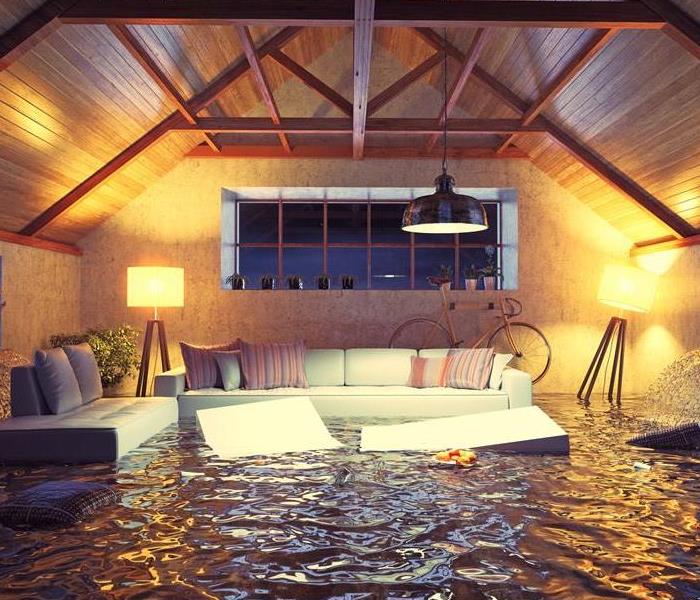 If you live in Clearfield, UT, bear in mind these tips in case of heavy storms and floods.
If you live in Clearfield, UT, bear in mind these tips in case of heavy storms and floods.
A heavy storm can lead to an invasion of flood water into your home. Before this happens, it's important to plan how you are going to handle it. The following tips not only can protect your house but also keep you and your family safe from risks associated with flooding.
Important tips to consider in case of heavy storms and floods
Gather Emergency Supplies
A natural disaster can result in loss of power or clean water. If this happens, you will need a few emergency supplies. While you can adjust your supply list to your family's specific needs, there are a few essential items that should be included in every emergency stash:
- Nonperishable food items in sealed, waterproof containers
- Bottled water
- First aid kit
- Essential medications
- Flashlights and batteries
- Personal protective equipment
Create a Flood Response Plan
Everyone in your family needs to know what to do if your home floods during a storm. Knowing when it's ok to stay and when you need to leave is crucial. Map out the best ways to get out of your home if the door is obstructed, and make sure everyone knows what is expected of them. It's easier to respond quickly to evacuation mandates if you already have a well-practiced plan in place.
Keep Drainage System Clear
Nothing leads to a flooded building faster than a deluge with no other place to go. Clean out your gutters and downspouts regularly to keep them clear of dirt, twigs and other debris. Make sure your drainage system directs flood water away from the foundation of your home rather than toward it.
Protect Important Belongings
You don't have to wait until the storm hits to protect your valuables. It's a good idea to always store important or delicate items on higher shelves or in the upper level of your home, especially important during storm season. Keep original copies of vital documents such as birth certificates, the deeds to your home and cars and other essential papers in water resistant containers. Digitize as many of your records as possible so that you don't lose the information if water restoration specialists can't salvage the paper copies.
Purchase Flood Prevention Equipment
You may not be able to completely avoid storm damage, but with the right equipment you can minimize it. A sump pump in your basement is a great line of defense against flooding. Even items as simple as sandbags can create a barrier between your home and rushing water.
Be Aware of Your Home's Flood Risk
Your flood plan is only as good as your risk awareness. If your home in Clearfield, UT is in a flood plain, you definitely need a separate flood policy as part of your insurance coverage. Even if the area where you live is not prone to flooding, a lawn that slopes toward your house rather than away from it or a lack of barriers between runoff and your foundation can cause significant problems during a storm. Knowing your risk level can help you take the necessary precautions to avoid or minimize water damage to your home.
There is a lot you can do to protect your home from damage due to flood water. Good preparation can help you weather even the strongest storm.
Understanding the Necessity of a Flood Cut After Flooding
10/26/2021 (Permalink)
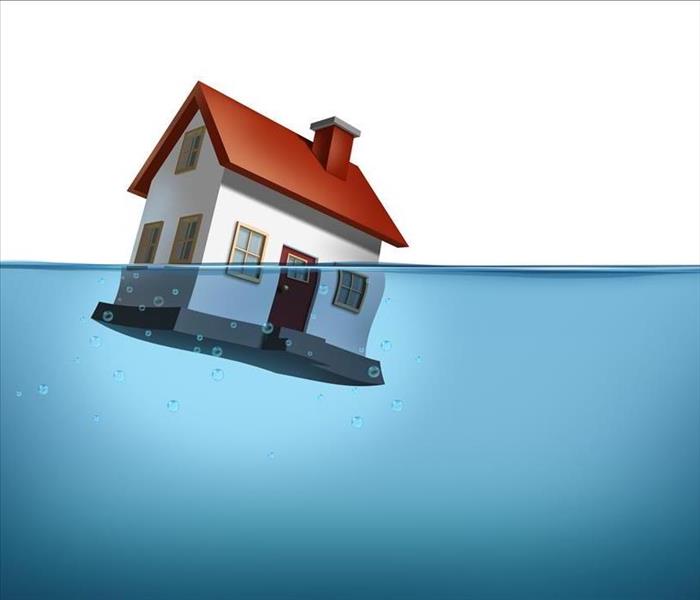 Flood cut after a flood in your Clearfield, UT home, it is indispensable to avoid contaminated water.
Flood cut after a flood in your Clearfield, UT home, it is indispensable to avoid contaminated water.
A flood cut is a necessary tool for remediation experts in Clearfield, UT. After flooding recedes, the remediation crew will make a cut at least 12 inches above the flood line. While it is called a cut, it involves the removal of drywall, insulation, and any other materials below the designated line. There are many reasons companies use flood cuts.
4 Reasons Remediation Companies Make a Flood Cut After Flooding
A flood cut is meant to help eliminate further risks of contamination. Many homeowners struggle to understand the objective of a cut because all they see is materials being removed from their homes.
While it can be challenging to watch as crews remove drywall, insulation, and other items from your home, know that there are several reasons for the apparent madness. In fact, there are at least four reasons for making a flood cut.
1. To Reduce the Risk of Mold
Remediation companies will tear out materials above a flood line to reduce the risks of mold. While a flood line shows where the water level rose, it does not show how much of that water was soaked into the insulation.
Remediation experts assert that 12 inches above is the minimum necessary cut to reach dry materials. Therefore, by removing above the flood line, you take away potential moisture sources for mold spores.
Mold can develop within one to two days after flooding. By making a flood cut, remediation crews cut down the risks of development.
2. To Dry the Area Thoroughly
A flood cut is also used to help dry an area after a flood. There is no other way to access a wall cavity than by removing sections of drywall and insulation. With the cavity exposed, remediation crews can use fans, air movers, and dehumidifiers to help dry the space thoroughly and quickly.
The speed a space is dried can also reduce the risks of other problems, like mold and structural issues. The longer water is allowed to stand, the more damage it can do to the integrity of your home.
3. To Inspect for Structural Damage
While flood cuts are necessary for avoiding extensive damages, they can also be used for inspecting the structure after a flood. By opening the walls, a restoration company can tell how much damage actually occurred. Water damage can lead to wood rot and foundational issues, making structural assessments crucial after a flood.
4. To Make Any Necessary Repairs
Floods can lead to electrical and plumbing issues. In many instances, the only way to get to the affected systems is by opening up the walls. Remediation experts will do their best to limit the amount they open walls, but again, 12 inches above the flood line is standard practice.
While flooding is a nightmare for most homeowners, it is not impossible to recover from the damage. With the right crews performing tried and tested techniques, you can have your home restored in no time. However, remember that the amount of work needed will depend on the length of time the floodwaters remained and how deep they were.
Don't Wait for an Insurance Adjuster To Take Action After Storm Damage
8/24/2021 (Permalink)
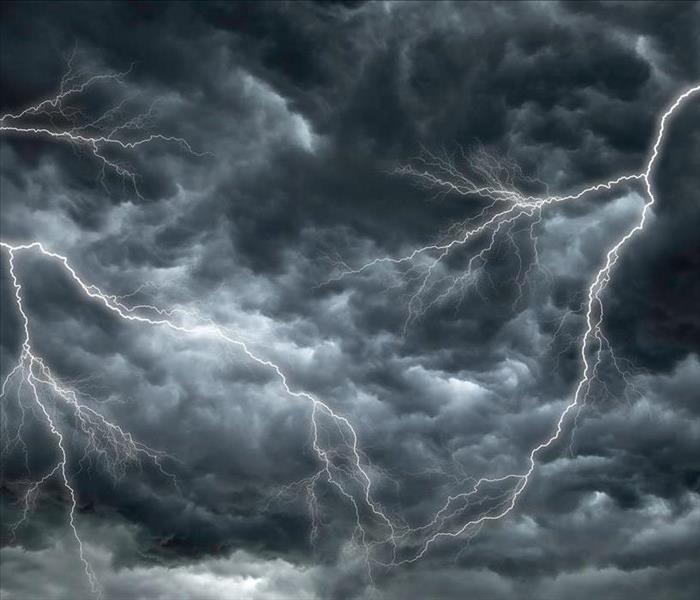 You can minimize the damage after a storm by taking simple steps to protect your insurance coverage.
You can minimize the damage after a storm by taking simple steps to protect your insurance coverage.
Storms can wreak havoc on residential properties; wind and flood damage can lead to significant primary and secondary damage. Even if you have flood insurance, it is crucial you do everything in your power to minimize damage and protect your claim, especially since insurance adjusters will likely be delayed following significant storm surges.
Water and storm mitigation experts in Clearfield, UT, recommend taking a pre-emptive approach to storm cleanup. Instead of waiting for an adjuster, reach out to a remediation specialist to start the restoration process, including:
- Mitigation
- Cleanup
- Restoration
Prevent Further Damage With Mitigation Protocols
If you want to protect your insurance coverage, you will need to take action after a storm. Most insurance companies require policyholders to mitigate further loss and damage in order to receive the total value of their coverage.
If you fail to clean up excess water or take action to minimize the risk of further damage, like mold damage, an adjuster can deny your claim altogether. Thankfully taking action does not have to be challenging. You can contact a mitigation company for assistance. The business will send out a team to assess the damage and take any necessary mitigation measures.
These services commonly work with insurance companies, so it is not unusual for them to understand what is needed to protect your policy and ensure you’re covered. You might want to contact your insurer to explain that you are calling a service, just in case there are any requirements in your policy you need to know about.
Mitigation Services Can Help With Cleanup While Keeping a Record of Loss
Most flood insurance companies will require a loss statement, including pictures and receipts of items damaged in the flooding. While homeowners can be hesitant to clean up after a disaster, worrying the cleanup will undermine the valuation, a mitigation and restoration service will document everything and help you establish a thorough report.
Restoration service will also create an itemized list of the services rendered or recommended, providing you with justification for any and all expenses. Ultimately, using a service helps ensure there is a record of every detail of a disaster for the adjuster when they arrive.
Rebuilding After Storm Damage
Once the adjuster has time to assess your property and claim, the restoration company should have a projection of the total cost of restoration. Your adjuster will be able to review all of the recommendations and determine whether the quote is fair and feasible.
The adjuster can then determine the amount you are covered for and provide approval for the continuation of work. Obviously, as the homeowner, you have a say in which company completes the restoration, but your insurer might have suggestions.
While flood insurance is helpful, especially after a storm surge, the homeowner needs to understand that response times after a flood can be slow. You do not have time to wait for an adjuster. You will need to take action to protect your policy and claim. After a flood or storm damage, make sure to take mitigative steps to protect against secondary damage.
How To Stay Safe After a Flood Invades Your Home
7/15/2021 (Permalink)
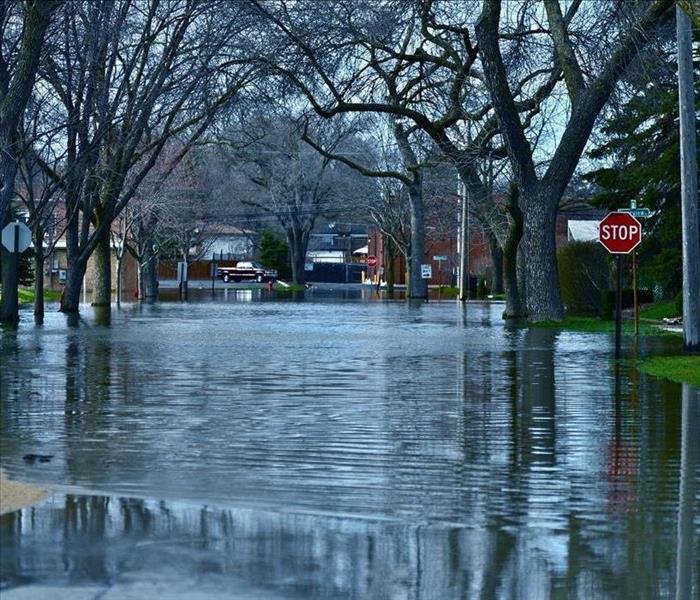 Street flooded in Clearfield, Utah
Street flooded in Clearfield, Utah
Flooding is a disaster that can happen in virtually any area, given the right set of circumstances. Whether from a hurricane that affects hundreds of miles of land or heavy rain that rushes into your basement, it can have devastating effects on the property, causing safety issues for you and your family. Familiarize yourself with the steps for flood safety before your home in Clearfield, Utah, is in a flood.
1. Investigate for Property Damage
Investigate your property for damage, such as downed power lines and structural harm, such as foundation cracks.
2. Check the Water Supply
You must check your water supply before you use it to make sure it's not contaminated. To be safest, check with your water supplier to make sure it's safe for drinking. Flood safety experts will advise that until you know for sure, you can boil water when you need clean water for drinking, washing, making ice, or preparing food.
3. Wear PPE for Cleanup
Before you begin cleaning, it's vital to wear personal protective equipment to keep you safe and avoid cross-contamination to unaffected areas. Safety glasses, a respirator, latex gloves are the minimum PPE you should wear.
4. Dispose of the Unsalvageable
Unfortunately, there could be a lot of unsalvageable property, and it's crucial to remove them from the area as soon as possible. This action will make more room for flood damage restoration professionals to operate. Food, medications, and cosmetics that have come in contact with the water must be thrown away. Soaked carpet and sections of drywall must be removed. Also, any saturated porous objects, such as wooden or upholstered furniture that can't be cleaned and thoroughly dried within 48 hours will need to be thrown away.
Being aware of flood safety methods can keep you safe and minimize property loss. Prepare for the possibility of the unthinkable by remembering these essential safety tips.



 24/7 Emergency Service
24/7 Emergency Service








